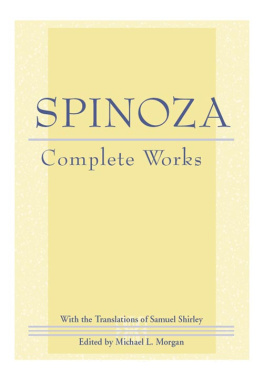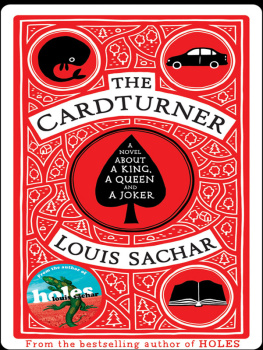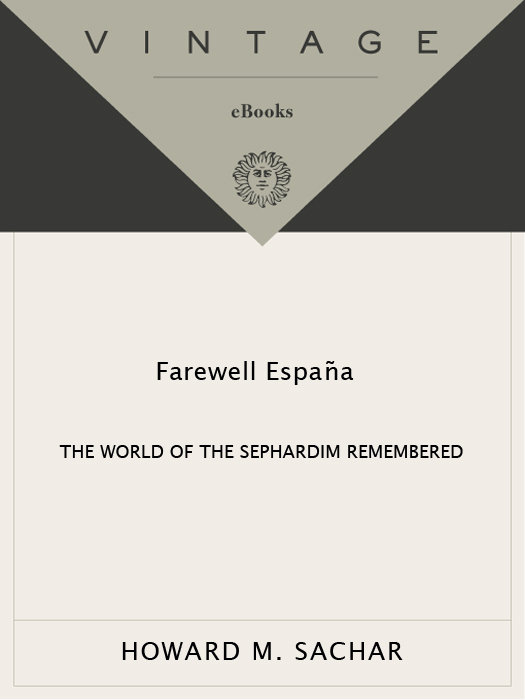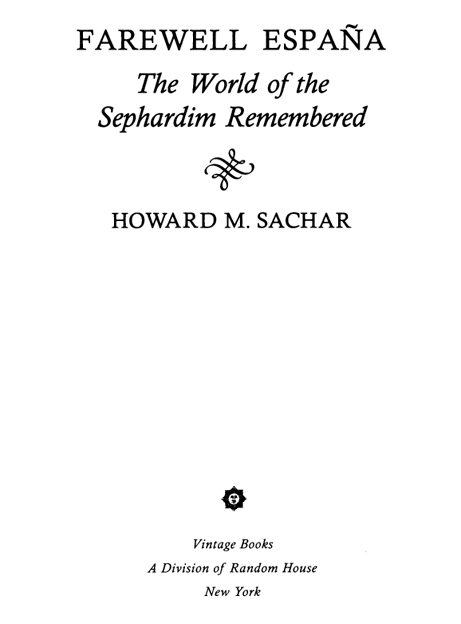HOWARD M. SACHAR
Farewell Espaa
Born in St. Louis, Missouri, and reared in Champaign, Illinois, Howard Morley Sachar received his undergraduate education at Swarthmore and took his graduate degrees at Harvard. He has taught extensively in the fields of Modern European, Jewish, and Middle Eastern history, and lived in the Middle East for six years, two of them on fellowship, the rest as founder-director of Brandeis Universitys Hiatt Institute in Jerusalem. Dr. Sachar has contributed to many scholarly journals and is the author of eleven previous books: The Course of Modern Jewish History (1958), Aliyah (1961), From the Ends of the Earth (1964), The Emergence of the Middle East, 19141924 (1969), Europe Leaves the Middle East, 19361954 (1972), A History of Israel: From the Rise of Zionism to Our Time (1976), The Man on the Camel (1980), Egypt and Israel (1981), Diaspora (1985), A History of Israel: From the Aftermath of the Yom Kippur War (1987), and A History of the Jews in America (1992). He is also the editor of the thirty-nine-volume The Rise of Israel: A Documentary History. Based in Washington, D.C., where he serves as Charles E. Smith Professor of History at George Washington University, Dr. Sachar is a consultant and lecturer on Middle Eastern affairs for numerous governmental bodies, and lectures widely throughout the United States and abroad. He and his family live in Kensington, Maryland.
ALSO BY HOWARD M. SACHAR
The Course of Modern Jewish History
Aliyah: The Peoples of Israel
From the Ends of the Earth: The Peoples of Israel
The Emergence of the Middle East
Europe Leaves the Middle East
A History of Israel: From the Rise of Zionism to Our Time
The Man on the Camel
Egypt and Israel
Diaspora
A History of Israel: From the Aftermath of the Yom Kippur War
A History of the Jews in America
FIRST VINTAGE BOOKS EDITION, OCTOBER 1995
Copyright 1994 by Howard M. Sachar
Maps copyright 1994 by George Colbert
All rights reserved under International and Pan-American Copyright Conventions. Published in the United States by Vintage Books, a division of Random House, Inc., New York, and simultaneously in Canada by Random House of Canada Limited, Toronto. Originally published in hardcover by Alfred A. Knopf, Inc., New York, in 1994.
Owing to limitations of space, all acknowledgments of permission to reprint previously published material will be found following the index.
The Library of Congress has cataloged the Knopf edition as follows:
Sachar, Howard Morley.
Farewell Espaa: the world of the Sephardim remembered / by Howard M. Sachar.
p. cm.
Includes bibliographical references.
eISBN: 978-0-8041-5053-8
1. JewsSpainHistory. 2. SephardimHistory.
3. SpainEthnic relations. I. Title.
DS135.S7S23 1994
946.004924dc20 93-39501
v3.1
In memory of Shira
niece, radiant spirit, soldier of Israel
CONTENTS
PROLOGUE
My enduring memory of Cecil Roth is of a spare, angular figure, his expression somewhat quizzical behind dark-framed spectacles, his lips mildly pursed, gazing reflectively from the third-floor balcony of my apartment on Mevoh Yoram Street in Jerusalem. The flat lay in the Kiryat Shmuel quarter, and in the early 1960s it looked out on the United Nations Truce Supervision Headquarters on the demilitarized Hill of Evil Counsel between the Arab and Jewish cities. It was a building Roth remembered well in its earlier, mandatory-era incarnation, when it functioned as the British High Commissioners Palace. In the 1920s and 1930s, he had been a frequent dinner guest there, and almost ideally in his element as he mingled with prominent figures of both the Zionist and British worlds. He much enjoyed reminiscing on the experience.
Cecil Roth was supremely an amalgam of those blended civilizations. London-born, he had earned his doctorate in general history at Merton College, Oxford, and then wrote and taught almost exclusively in the field of Jewish history. Even within that uniquely prismatic culture, Roth had become enamored early on of the Sephardic heritage. His cascade of scholarly works on the Jews of Spain, Portugal, Italy, and the Ottoman Empire, and their progeny in England, became more than the standard of Sephardic studies; for ensuing generations, it served as the wellspring of Sephardic historiography altogether. As the reading list even for this brief, impressionistic appraisal would suggest, no explorer in the field can yet presume to find his bearings without extensive exposure to Cecil Roths magisterial volumes and articles on Sephardica. And surely no other scholarly works on that topic can begin to compare with his in sheer literary felicitousness.
Roth himself was the product of a Central EuropeanAshkenazicfamily, and little in his ancestral tradition prefigured an affinity for the Mediterranean strand in his peoples mosaic. Yet his research was impelled by his temperament. Roth loved life. No theatrical or musical performance, no soire, festive event, or intimate gathering, was too trivial for his delectation. Like others of his younger friends, I was drawn willy-nilly into the mans gravitational field. Whether recuperating from a long trip, an arduous writing project of my own, or even an illness, I would not be permitted a moments self-commiseration. Cecil and Irene Roth were on the telephone to inform (not ask) me to prepare myself: we were going to attend this or that museum exhibition, so-and-sos birthday party, or such-and-suchs public celebration. Only long after Roths passing in 1970 did it occur to me that he had been drawn to the Sephardic world precisely for its own characteristic joie de vivre, its brilliance of plumage, its genial, accommodating, tolerant affection for lifes pleasures and excesses, even its frailties.
Cecil Roth was a scholar, not a moralizer. Amidst a resurgent ideological zealotry that has tinctured elements of his own people (in common with those of not a few other nations), the vibrant, inquiring, pluralistic civilization that he more than any other scholar reconstructed and immortalized can be allowed to teach its own lessons. Meanwhile, the general reader may yet be intrigued by the achievements and vicissitudes of a protean, if demographically modest, subcommunity. There was a time when that fecund Sephardic leaven determined the cultural physiognomy of the Jewish people in their entirety.
In the preparation of this volume, I have benefited from the guidance and counsel of a number of eminent authorities. Professor M. Mitchell Serels, director of Sephardic Community Programs for Yeshiva University, generously opened out for me an extensive list of contacts overseas. Most of these individuals are cited in the text, but there are others whom I must also mention: For Portugal: Dr. Joshua Ruah and Mr. Solomon Marques, respectively president and former president of the Jewish Federation of Lisbon; Rabbi Avraham Assor of Lisbons Sephardic Synagogue; and Mr. Narcisse Ari, also of Lisbon, businessman and distinguished historian of Portuguese Jewry. For Spain: Mr. Simon Hassan, engineer, of Seville; his brother, Mr. Yaakov Hassan, curator of Judaica at the Arias Montano Institute in Madrid; Mr. Leon Sorenssen, executive director of the Jewish Community Center of Barcelona; and Mr. Alberto Hasson, businessman, of Barcelona.






